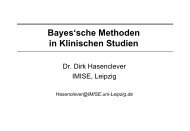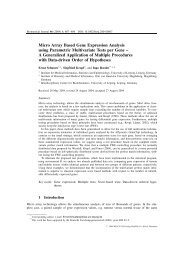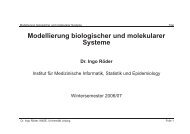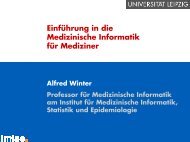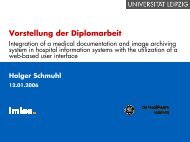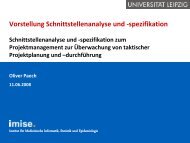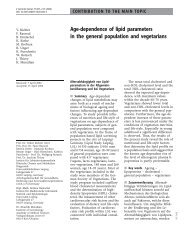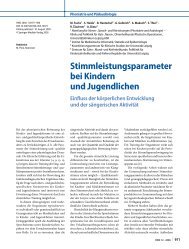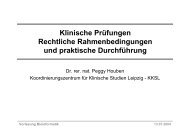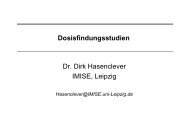MS-1513 CCND1 and HNPCC by Kruger et al. revised - IMISE
MS-1513 CCND1 and HNPCC by Kruger et al. revised - IMISE
MS-1513 CCND1 and HNPCC by Kruger et al. revised - IMISE
You also want an ePaper? Increase the reach of your titles
YUMPU automatically turns print PDFs into web optimized ePapers that Google loves.
1. Introduction<br />
Cyclin D1 (encoded <strong>by</strong> <strong>CCND1</strong>) is a major regulator of the cell cycle, playing a key<br />
role in the G 1 to S phase transition. <strong>CCND1</strong> harbours a common G/A sequence variation at the<br />
last nucleotide of exon 4, increasing <strong>al</strong>ternate splicing. <strong>CCND1</strong> mRNA is <strong>al</strong>ternately spliced<br />
to give two simultaneously occurring transcripts a <strong>and</strong> b. The regularly spliced transcript a is<br />
spliced b<strong>et</strong>ween exons 4 <strong>and</strong> 5 <strong>and</strong> contains both exons, while the unspliced transcript b reads<br />
into intron 4 <strong>and</strong> is lacking exon 5. Transcripts arising from the 870A <strong>al</strong>lele are less likely to<br />
be regularly spliced than those from the 870G <strong>al</strong>lele [1]. Both transcripts encode proteins that<br />
contain amino acids 55–161, thought to be responsible for the cyclin D1 function. However,<br />
transcript b is lacking exon 5, encoding a PEST destruction box responsible for the rapid<br />
turnover of the protein. Therefore transcript b was thought to have a longer h<strong>al</strong>f-life than<br />
transcript a [1]. Recently, Solomon <strong>et</strong> <strong>al</strong>. found that cyclin D1b is not significantly more<br />
stable than cyclin D1a, rather is a poor effector of RB phosphorylation/inactivation <strong>and</strong><br />
disrupts contact inhibition in a manner distinct from cyclin D1a [2]. It has been suggested that<br />
the <strong>CCND1</strong> 870A <strong>al</strong>lele is associated with susceptibility to various tumours, including<br />
sporadic colorect<strong>al</strong> adenoma [3], <strong>and</strong> sporadic colorect<strong>al</strong> cancer [4,5], famili<strong>al</strong> colorect<strong>al</strong><br />
cancer [6], squamous cell carcinoma of the head <strong>and</strong> neck [7], squamous cell carcinoma of the<br />
upper aerodigestive tract [8], urinary bladder cancer [9], sporadic ren<strong>al</strong> cell carcinoma [10],<br />
prostate cancer <strong>and</strong> benign prostatic hyperplasia [11], but not colorect<strong>al</strong> cancer associated<br />
with <strong>HNPCC</strong> [6], breast cancer [12,13], <strong>and</strong> esophage<strong>al</strong> squamous cell carcinoma [14].<br />
<strong>CCND1</strong> is overexpressed in about a third of colonic adenocarcinomas [15]. A role for<br />
cyclin D1 in colorect<strong>al</strong> carcinogenesis was further suggested since expression of anti-sense<br />
<strong>CCND1</strong> cDNA suppresses the growth of cancer cells in nude mice [16]. Autosom<strong>al</strong><br />
dominantly inherited hereditary nonpolyposis colorect<strong>al</strong> cancer (<strong>HNPCC</strong>), one of the most<br />
common cancer susceptibility syndromes, is caused <strong>by</strong> germline mutations in the DNA<br />
mismatch repair (MMR) genes, mainly <strong>MS</strong>H2 <strong>and</strong> MLH1 [17], <strong>and</strong> shows a wide range in its<br />
age of ons<strong>et</strong> (AO) ranging from 16 to 90 years [18]. To date, two studies have investigated the<br />
association b<strong>et</strong>ween <strong>CCND1</strong> G870A variation <strong>and</strong> AO in <strong>HNPCC</strong> with contradictory results:<br />
Kong <strong>et</strong> <strong>al</strong>. an<strong>al</strong>ysed 86 mutation carriers (49 CRC cases <strong>and</strong> 37 unaffected mutation carriers),<br />
most of them non-hispanic white Americans, with truncating (n = 46, 53.5%) or missense (n =<br />
40, 46.5%) mutations in <strong>MS</strong>H2 or MLH1, <strong>and</strong> found that subjects with <strong>CCND1</strong> AA <strong>and</strong> AG<br />
genotypes developed CRC on average 11 years earlier. They were 2.46 times more likely to<br />
g<strong>et</strong> cancer during any interv<strong>al</strong> than those with GG genotype (hazard ratio 2.46, 95%<br />
4



